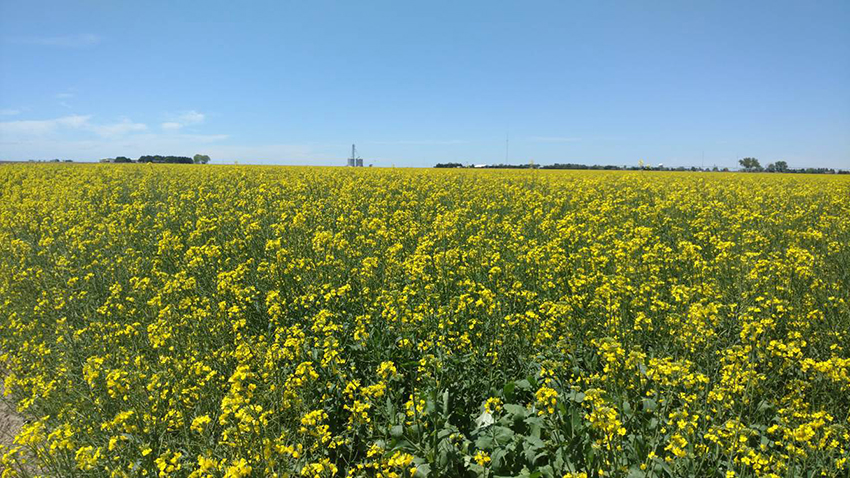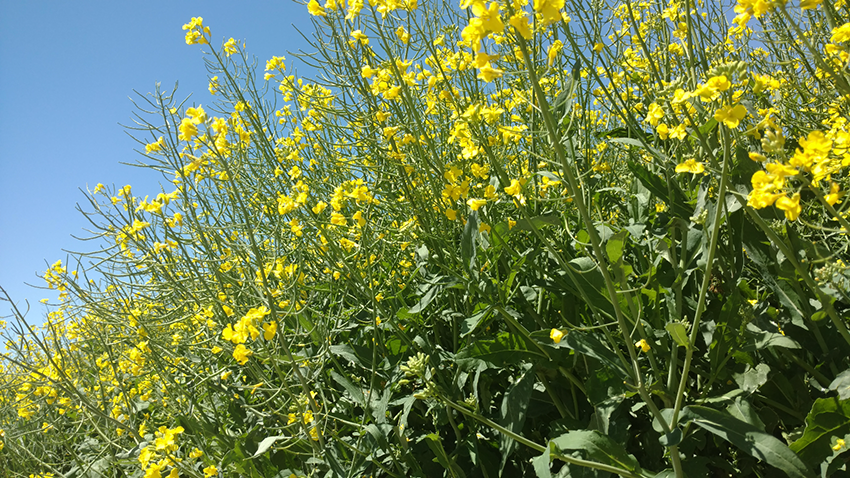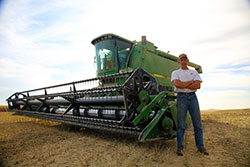|
What Is Better Than A Cover Crop?
Winter Canola, Has the potential to bring good
revenues and
clean up ground and outperform cover cropping.
Reduces Compaction, improves soil stored
carbon and is tough on Nematodes.
A rotation for the Great Plains about every 3rd to 4th year.

At 3,800feet above sea level, Goodland, KS. In sight of I-70,
Greg Sederstrom. The ideal No-tillage crop.
Winter Hardy, Hybrids have bred Structural Strength to recover from
Great Plains winters.
Top notch varieties come from Rubisco, Mercedes and Hornet. European
Hybrids breeding up in Kentucky for the US Great Plains.
Oklahoma State, University of Idaho, and Kansas State are also
involved in breeding with Open Pollinated varieties like Riley or
Torrington.
Hybrids take the lead vs. the open pollinated varieties. Private and
public breeding is greater and greater.
A viable crop across the Great Plains to mile high Denver.
Nutrients are TAPPS, TAPPKTS single disc banded.
Nutrients for 80 bushel per acre Winter Canola. Exactrix TAPPS
Banded. 100 lbs. N as NH3, 30 lbs. P and 30 lbs. S as Thio-sul®
For true NPKS applications banded deep consider, Potassium
Thio-Sulfate KTS® should also be considered with Boron and Zn,Cu, Mn,
and other metals.
Thio-Sul® builds protein and oil content. Thio-sul is
12-0-0-26S at 11.1 lbs per gallon and is the best sulfur choice
banded with low cost NH3.
Premiums are paid at the Goodland ADM plant when oil content exceeds
42%.
The fertilizer bill is greatly reduced by building protein and oil
with Thio-sul®.
Exactrix prescription of TAPPS and TAPPKTS, Enough sulfur has been
applied to make 48% to 50% oil content. TAPPS was applied twice in
No-tillage with Mustangs utilized in the growing crop.
A giant world market, tracking the oil
seed complex.
A multiplex market with several different directions to hedge your
marketing bets in the US and export.
The products are Bio Diesel, Cooking Oil, and an ideal feed for
Dairies. A world market crop.
Third in the world for oil seeds with a tremendous growth record in
the US with the health food consumers.
An Ideal No-tillage Crop.
In 2017, 22.7 million acres on the prairies of Canada in
No-tillage systems. China bought $2 Billon of Canola from Canada
in an August deal in 2016.
A missing link on the Great Plains out competing the traditional 2
year winter wheat rotation.
This crop will take away from winter wheat, irrigated and dryland
corn and milo acres all of which need to be diluted.
Winter Canola harvest is early and will allow for double crop under
irrigation systems in SW Kansas.
This crop frees up rotations and drives wheat yields much higher
with clean sanitized soils resulting. Tough on Nematodes and
functional in Corn Rotations.

Planted on 30 inch rows. Insurable across the Great Plains, Has
potential to become a premier crop for the Great Plains,
displacing wheat and cover crops.
Planting reduces seed costs (60,000 to 90,000) and raises yield
potential. Stronger plants and better crowns result with 20 inch and
30 inch planting singulated 4 to 6 inches apart.

A sure bet, typically 10% increases in
yield with winter wheat and known yield increases in corn but yet to
be documented with corn.
Acreage should double and possible triple again in Kansas for the
2018 crop.
Open pollinated, lower cost varieties are available from U of I,
KSU, and OSU.

Winter Canola Ships to Lubbock, TX, ADM, or Goodland, KS, ADM,
Winter Canola crush is preferred by dairies with about 3% more milk
produced over soy.
Harvest is 30 days away on May 26, 17 at Goodland. Direct cutting is
planned using a Reglone or Roundup depending on variety.

This Goodland crop survived minus 15 degrees F on December 8th.
Hornet and Mercedes, Rubisco Hybrids are top notch selections for
West Texas to Nebraska.

Why plant Winter Canola? The plant is stronger and more
regenerative for the time invested.
Winter Canola at 3,100 feet at Hugoton, KS. Hybrid Vigor shows in
the branching from the crown. Rubisco, Hornet.
This Joel McClure field survived Winter storm Ursa on April 28 to
May. 1, 17.
A 100 year storm, The snow trap and the 4 week blooming field was
totally buried with 15 to 20 inches of snow.
When properly fertilized and No-tillage planted the crop is a
survivor.
Winter Canola is famous for reducing compaction and the crop cleans
up weeds and disease.
Winter Canola is tough on Nematodes.
An Ideal crop for sandy soils to build structure and add value to
nutrient management.

What is the number 1 reason producers are planting Winter Canola
in late August and early September?
Money, a chance to make a good profit and
a much better choice than fall seeded winter wheat.
In dryland, Winter Canola at 40 bushel yields with $7.50 to $8.00
offered with the oil premium with cost of production very close to
Winter Wheat.
In irrigated, Winter Canola at 80 to 90 bushel yields with $7.50 to
$8.00 offered with the oil premium with cost of production very
close to or 15% above Winter Wheat (insect control varies widely).
A break in rotation with higher yields following Winter Canola.
Note1: Winter Canola is a good solution for 25% to 33% of the
acres.
The best return will still require cool season rye, winter wheat and
triticale to build soil in sandy soils on the balance.
Note 2: Selection of fertilizers in TAPPS and TAPPKTS
formulators. TKI summation.
KTS® is 0-0-25-17S, Potassium Thio-Sulfate.12.2 lbs per gallon, 7 to
8.2 pH, Cold Temperature functional to 0to 15 degrees F.
Thio-sul® is 12-0-0-26S, Ammonium Thio-Sulfate, 11.1 lbs per gallon
at 6.5 to 8.5 pH and crystallizing at 45 degrees F.
APP, Poly Phosphate, Ammonium Poly Phosphate, 10-34-0. 11.7 lbs. per
gallon or 11-37-0, 12 lbs. per gallon. 10-34-0 is ideal in cold
temperatures to 15 degrees F.
TAPPS is typically formulated at 108 lbs. N as Ammonium(NH3), 48 lbs
P and 32 lbs. S. Tri-Ammonium Poly Phosphate Sulfate or TAPPS.
TAPPKTS is typically formulated at 108 lbs N as Ammonium(NH3) 48
lbs. P, 10 lbs, K and 39 lbs. S. Formulations are adjusted upward or
downward based on soil test.
Contact Exactrix for typical TAPPS and TAPPKTS blends and proper use
of micronutrients in 1% CV bands using process controls of Exactrix.
How critical is Thio-Sul to make NH3 stable in the
soil.

In Nebraska conditions at 6.5 soil pH, fall
banding of TAPPS as compared to TAPP (Thio-sul® not included)
resulted in 7.8 to 11 more bushels per acre of corn.
Thio-Sul® resulted in 7.8 to 11 more bushels per acre at 10 lbs S
(3.4 gal/a.) and 20 lbs. S (7.8 gal/a.)
Thio-Sul® is known to and is promoted by Exactrix to stabilize
Nitrogen. Much better than N serve.
And now another serendipitous discovery and a key feature. Less
upward volatility of Ammonium into the germination zone.
Now we know that under certain weather and soil conditions Thio-Sul®
not only stabilizes Ammonium nitrogen delaying it’s movement
downward.
Thio-Sul® also delays and helps Ammonium from moving upward in the
soil into the germination zone.
We would expect KTS to perform the same.
Your Great Plains Reporter.

Guy Swanson
Monsanto expert: Cover crop benefits accumulate
over time.
Published in Ag Daily.

Whether you’re planting cover crops to get nitrogen back into the
soil or to assist with erosion control, it’s a process that requires
patience.
According to Cody Jones, a technical agronomist with Monsanto, a
first-time cover crop grower should set their expectations correctly
so they don’t set themselves up for disappointment.
“The benefits of cover crops accumulate over time. It’s not
something they are going to see a huge benefit from the first year
and that they are going to see that same benefit every year,” said
Jones, who lives in West Texas and supports the Channel brand across
the Southwest. “For erosion control and wind protection, you see
that immediately. But if you’re talking about improving soil health
— whether that’s nutrients, organic matter, or soil structure —
those benefits accumulate over time.”
For instance, some of Jones’ growers have seen a 1 ½ to 2 percent
yield increase the first year planting a cover crop. Three years
into it, those same growers have seen an 8 to 10 percent yield
increase.
Before planting cover crops, Jones said growers also need to
consider their primary objective for doing it.
“Is that erosion control? Is it providing nitrogen for a subsequent
crop? Is it trying to scavenge residual nitrogen so it doesn’t leach
out and get lost?” Jones said. “Or is it alleviating soil
compaction? Or is it a forage for winter grazing? Once you define
your objectives that will define what you plant and when you plant
it.”
Jones said if planting a legume or a grass legume mix to add
nitrogen for a subsequent crop, that would need to be planted a
little bit earlier — either right at maturity of the previous crop
or as soon as you can get in afterwards to get some growth on. If
it’s a cereal rye or wheat, that can be planted after you harvest
your other crop.
In West Texas, most of Jones’ clients are planting cover crops due
to the wind and sandy soils in order to provide protection for the
young seedlings coming up in next year’s crops. Most of their choice
cover crops for the region are wheat or rye, with some oats. They
are planted in the fall and then let go through the winter.
Jones said some of his growers have found success planting solid
across the field while others have planted in the middle to save on
seed cost and to deal with lack of moisture.
“A lot of our guys strip till and it just leaves kind of a clean
little row that they can run their strip till rig down and plant
right back into it,” Jones said. “It doesn’t have to be planted
solid to protect from the wind as long as there is something out
there standing versus bare. Sixty to 80 percent ground cover is
still way better than bare dirt.”
Finally, Jones said growers need to consider when and how they are
going to terminate the cover crop.
For legumes in the North a winter kill can be used. Tillage is
another option, but often not a popular choice to control cover
crops. In the South, Jones said almost all growers terminate
chemically about two to four weeks prior to planting the next crop.
Growers should also keep in mind when they will need to terminate it
and when they are going to plant the next crop into it.
“Legumes, you want to leave up as long as you can to get as much
nitrogen as you can. With cereal crops, you don’t want to let it get
to the reproductive stage and head out because it will cost to try
to kill it,” Jones said. “As far as planting back into a cereal, I
like my guys to kill it at least two weeks if not a month before
they plan on planting. That way I know it is not getting to big and
its completely dead when they plant into it so it’s not using
critical moisture that the corn or soybeans might need to germinate
and get going.”
Last, but not least … be patient.
“Know that it takes time,” Jones said. “It’s not an instant fix,
just like most things we do in agriculture.”
 |
 |
 |
|
Exactrix TAPPS Formulators |
EXACTRIX TAPPS |
Crucible of TAPPS, TAPPKTS
Injection Inoculation. |
|
















